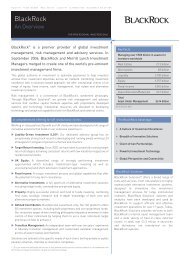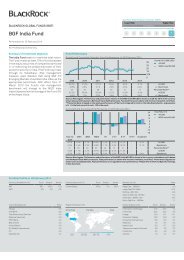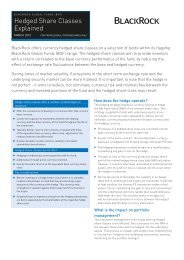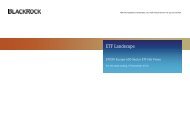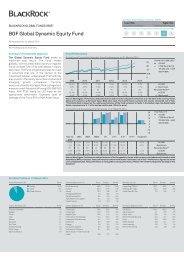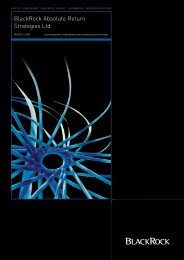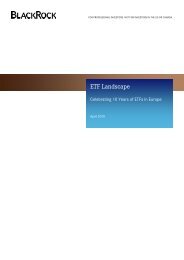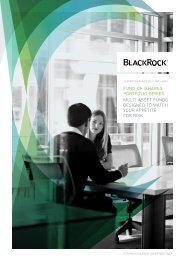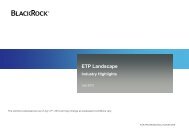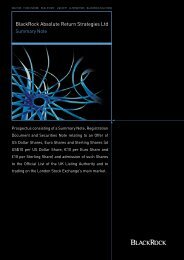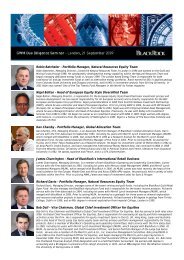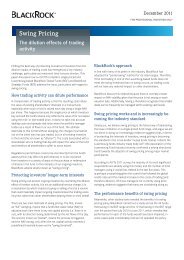ETF Landscape: United Kingdom Industry Review - BlackRock ...
ETF Landscape: United Kingdom Industry Review - BlackRock ...
ETF Landscape: United Kingdom Industry Review - BlackRock ...
You also want an ePaper? Increase the reach of your titles
YUMPU automatically turns print PDFs into web optimized ePapers that Google loves.
<strong>ETF</strong> <strong>Landscape</strong> Year End 2010<strong>United</strong> <strong>Kingdom</strong> <strong>Industry</strong> <strong>Review</strong> from <strong>BlackRock</strong>Figure 35: Deciding on which product to use depends on many factorsConsiderations Questions Products Product structure Domicile Country registrations Portfolio holdings Assets Under Management Average daily trading volume <strong>ETF</strong> provider / manager Transparency Client service Product choice What is my benchmark? What are my regulatory guidelines? What are my mandate constraints? What are my counterparty riskguidelines? What are my tracking riskguidelines? How can I gain long and/orshort exposure? How can securities lendingadd value? What is my time horizon? What are the tax implications? What are my liquidityrequirements? What costs are involved? Portfolio trading <strong>ETF</strong>s ETNs ETPs Swaps Futures Options Securitised products:certificates, warrants,equity linked notes,local access products LiquiditySource: Global <strong>ETF</strong> Research and Implementation Strategy Team, <strong>BlackRock</strong>.Factors to consider when selecting an <strong>ETF</strong>Objectives: assess your financial goals.Strategy: look for the right <strong>ETF</strong> to complement your portfolio.Ensure you read the prospectus and other documentation publishedby the <strong>ETF</strong> provider prior to investing.Risks: the value of your investment may go up or down. Check thespecific risks (i.e. political, economic and currency risks wheninvesting in an <strong>ETF</strong> providing exposure to an emerging market,country or region) and tax implications.The index: even <strong>ETF</strong>s with very similar sounding names can bebased on very different constituents. Index providers have differentindex methodologies which will determine the holdings, weights andrebalance frequency, which will result in different risk and rewardcharacteristics. Understanding the index is an important step inthe process.The structure: regulatory changes and innovations in structureshave seen ETPs move beyond the conventional open-ended fundstructure of an <strong>ETF</strong>. Additionally, open-ended funds can, in manyjurisdictions, embrace the use of swaps and other derivatives, whichmay change the risk characteristics and may limit the product’stransparency compared to traditional physical <strong>ETF</strong>s, particularly inrelation to the fund’s list of holdings. The size of the <strong>ETF</strong> in terms ofAUM will often dictate how much certain investors can invest inan <strong>ETF</strong>.Total costs: the fund’s Total Expense Ratio (TER), not just theManagement Expense Ratio (MER), is a major considerationwhen comparing costs between <strong>ETF</strong>s. Trading costs, tracking risk,registrations, trading currency, dividend withholding rates andsecurities lending within the fund and lending of the <strong>ETF</strong> should allbe considered.Liquidity: <strong>ETF</strong>s afford investors two forms of liquidity. The first isthrough trading the shares on a secondary basis on-exchange. Thesecond is on a primary basis via the unique ‘creation’ process,whereby an AP purchases the underlying basket of securities in thelocal market and deposits the basket ‘in kind’ into the <strong>ETF</strong>, creatingmore shares in that <strong>ETF</strong>. The unique creation/redemption processmeans that the liquidity in the <strong>ETF</strong> is driven by the liquidity in theunderlying securities. Similar indices can have different liquidityprofiles based on their index methodology.<strong>ETF</strong> provider: the type and amount of information provided ontheir <strong>ETF</strong>s, index construction and methodology, tax and indexmanagement knowledge, as well as the level and type of supportprovided to investors, intermediaries and brokers varies based onthe size, scale and expertise of the provider.This document is not an offer to buy or sell any security or to participate in any trading strategy. Please refer to important information and qualifications at the end of this material. 32



